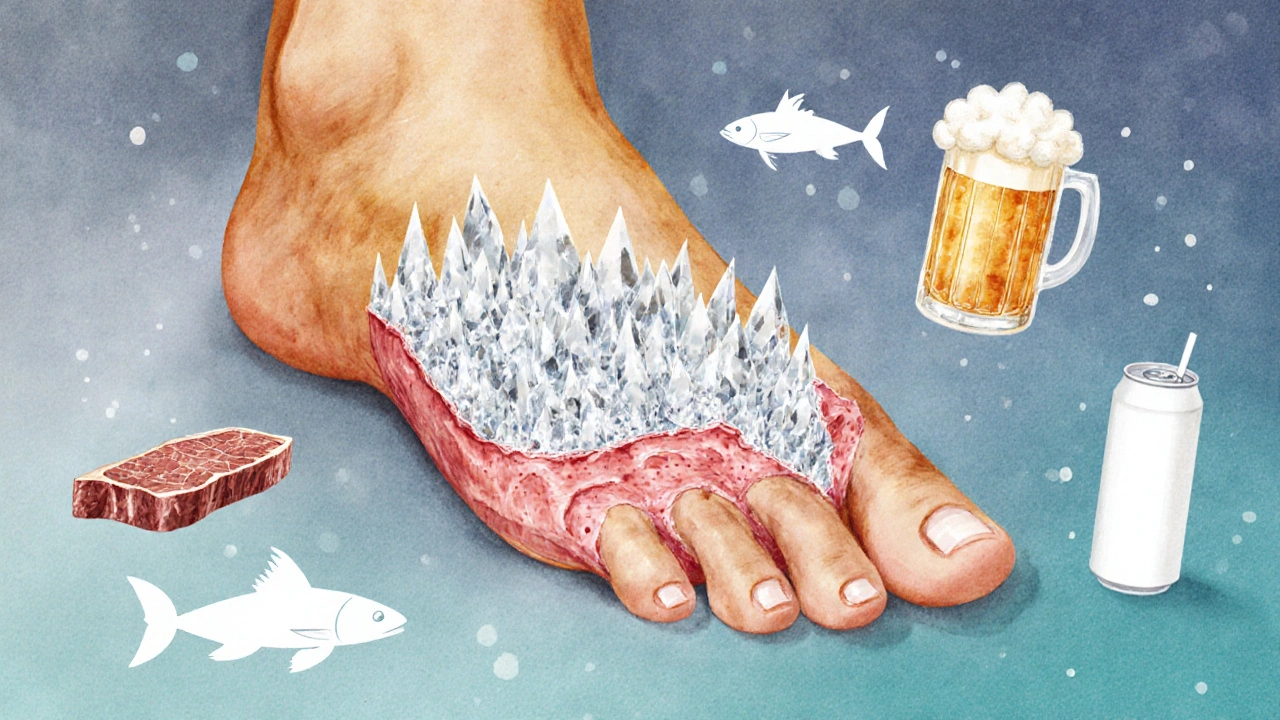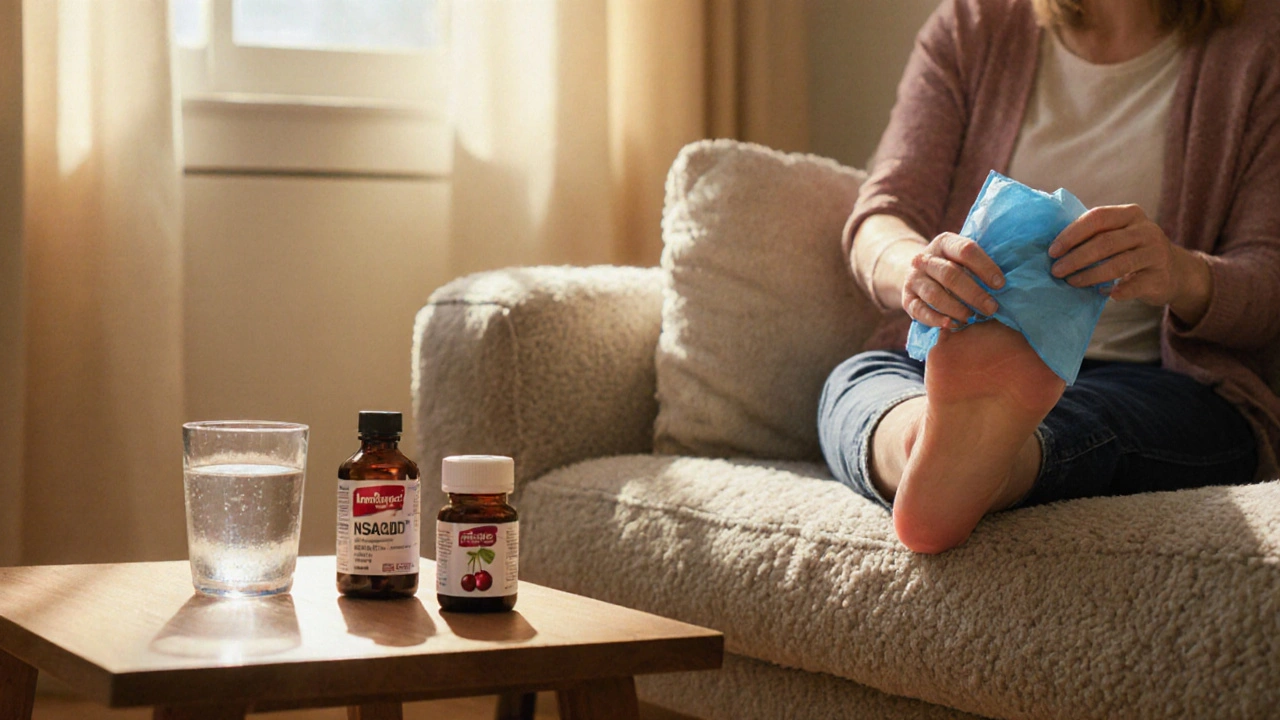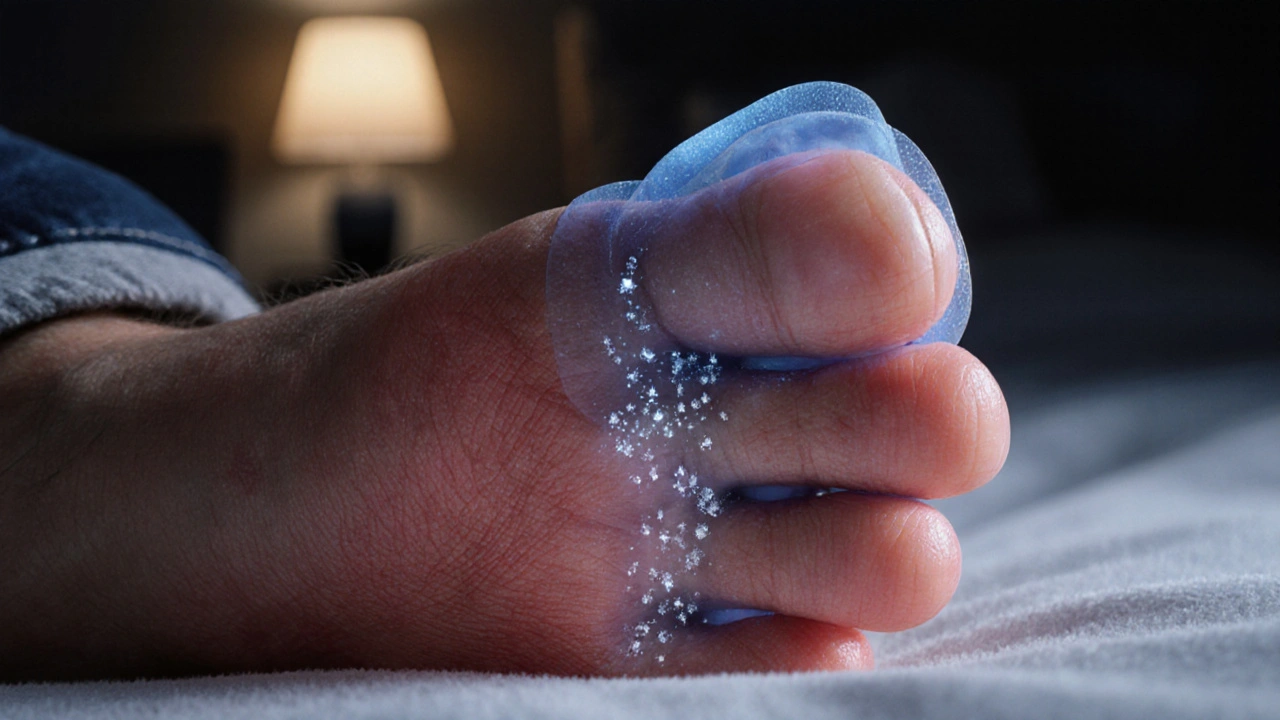Gout Risk Calculator
Assess Your Gout Risk
Enter your lifestyle factors to estimate your risk of gout-related joint pain.
Ever felt a sudden, stabbing ache in your big toe that seemed to come out of nowhere? Chances are you just experienced a gout flare, a classic example of how a metabolic hiccup can turn a simple joint into a pain machine. Below we break down why gout and joint pain are practically twins, how to spot a flare before it wrecks your day, and what you can actually do to keep the hurt at bay.
What Is Gout?
gout is a form of inflammatory arthritis that occurs when uric acid a waste product from the breakdown of purines in food and DNA builds up in the bloodstream and forms monosodium urate crystals sharp, needle‑like deposits that lodge inside joints. The body treats these crystals like an invader, sending white blood cells to attack, which creates the intense swelling and burning sensation most people associate with gout.
How Gout Leads to Joint Pain
When hyperuricemia blood uric acid levels above the normal range (typically >6.8mg/dL) persists, the excess uric acid becomes supersaturated and precipitates as crystals. These crystals tend to settle in cooler body parts-like the big toe, ankle, or knee-because lower temperatures favor crystal formation. Once the crystals settle, the immune system launches an inflammatory response that releases cytokines, prostaglandins, and other pain‑inducing chemicals. The result is a rapid, throbbing pain that can peak within 24hours and last for days if untreated.
Recognizing Gout vs. Other Causes of Joint Pain
Joint pain isn’t exclusive to gout. Conditions such as osteoarthritis and rheumatoid arthritis can mimic some symptoms, but key differences help you tell them apart. The table below lines up the most common clues.
| Condition | Typical Joint Affected | Primary Cause | Inflammation Pattern | First‑Line Treatment |
|---|---|---|---|---|
| Gout | Big toe, ankle, knee | Uric acid crystal deposition | Sudden, intense, often at night | NSAIDs, colchicine |
| Osteoarthritis | Weight‑bearing joints (knees, hips) | Cartilage wear‑and‑tear | Gradual stiffness, worsens with use | Physical therapy, pain relievers |
| Rheumatoid Arthritis | Small hand/foot joints | Autoimmune attack on synovium | Symmetrical swelling, morning stiffness | DMARDs, biologics |

Common Triggers and Lifestyle Risk Factors
Even if your blood uric acid is borderline, certain habits can tip you over into a flare. Here are the usual suspects:
- High‑purine foods: Red meat, organ meats, sardines, and shellfish.
- Alcohol: Beer and spirits raise uric acid production and reduce its excretion.
- Fructose‑rich drinks: Soft drinks and fruit juices can boost uric acid synthesis.
- Dehydration: Less water means uric acid stays concentrated, fostering crystal formation.
- Kidney issues: Impaired kidneys can’t filter uric acid efficiently.
Genetics also play a role; if a close family member has gout, your risk jumps by about 30%.
Treatment Options That Actually Work
When a gout flare strikes, the goal is two‑fold: calm the inflammation fast and keep uric acid levels low for the long run.
Rapid‑Relief Medications
NSAIDs non‑steroidal anti‑inflammatory drugs such as ibuprofen or naproxen are usually the first line because they curb pain and swelling within hours. If NSAIDs aren’t tolerated (e.g., due to stomach ulcers), doctors often turn to colchicine a plant‑derived alkaloid that interferes with crystal‑induced inflammation. Colchicine works best when started within the first 12hours of a flare.
Long‑Term Uric‑Lowering Therapy (ULT)
For people with frequent attacks, daily uric‑lowering medication becomes essential. The most common choices are:
- allopurinol a xanthine oxidase inhibitor that reduces uric acid production.
- Febuxostat (another xanthine oxidase inhibitor, often used when allopurinol isn’t tolerated).
- Uricosurics like probenecid, which help kidneys excrete more uric acid.
These drugs don’t relieve an active flare but prevent future crystal buildup, lowering the chance of another painful episode.
Dietary and Lifestyle Tweaks
While medication does the heavy lifting, lifestyle changes act like a safety net:
- Drink at least 2liters of water a day.
- Limit purine‑rich foods to a few servings per week.
- Swap sugary drinks for water, tea, or coffee (moderate amounts).
- Maintain a healthy weight; each kilogram lost can shave 0.5mg/dL off serum uric acid.
When you combine these habits with the right meds, you’ll see your flare frequency drop dramatically.
Managing a Flare at Home
If you’re mid‑flare, here’s a quick action plan that can calm things down before you see a doctor:
- Rest the affected joint and elevate it above heart level.
- Apply a cold pack for 20minutes, three times a day, to shrink swelling.
- Take the prescribed NSAID dose with food to protect your stomach.
- Hydrate aggressively-aim for a glass of water every hour.
- Avoid alcohol and high‑purine meals until the pain subsides.
If pain persists beyond 48hours despite OTC NSAIDs, call your healthcare provider. You may need a short course of colchicine or a steroid injection.

When to Seek Professional Help
Most gout flares are manageable, but certain signs call for immediate medical attention:
- Fever over 101°F (38.3°C) accompanying joint pain.
- Rapidly spreading redness or warmth, which could signal infection.
- Swelling that doesn’t improve after 72hours of NSAID therapy.
- Kidney stones, which often appear in chronic gout sufferers.
Prompt treatment can prevent joint damage and keep those dreaded tophi from forming under the skin.
Key Takeaway
Understanding that gout is more than just a bad toe-it's a systemic issue tied to uric acid, diet, and kidney health-puts you in the driver’s seat. By recognizing early symptoms, using fast‑acting meds, and committing to lifestyle tweaks, you can break the painful cycle and keep your joints moving smoothly.
Frequently Asked Questions
Can gout affect joints other than the big toe?
Yes. While the big toe (the first metatarsophalangeal joint) is the classic site, gout can also flare in the ankle, knee, wrist, and even the fingers. The pattern usually follows cooler, peripheral joints.
How long does a typical gout flare last?
A flare often peaks within 24hours, improves over 3-5 days with treatment, and can resolve completely in about a week. Untreated attacks may linger for two weeks or more.
What are tophi and when do they appear?
Tophi are lumps of monosodium urate crystals that deposit under the skin, usually around joints, ears, or the olecranon. They typically develop after years of uncontrolled hyperuricemia and signal chronic gout.
Is a low‑purine diet enough to cure gout?
Diet alone can lower uric acid modestly, but most patients need medication to achieve target serum levels (<6mg/dL). Combining diet with drugs gives the best long‑term control.
Can I take NSAIDs if I have stomach ulcers?
Generally not. NSAIDs can aggravate ulcers. In such cases, doctors prefer colchicine or a short steroid burst, and they may prescribe a proton‑pump inhibitor to protect the stomach.
Are there natural supplements that lower uric acid?
Vitamin C (500mg daily) and cherry extracts have shown mild uric‑lowering effects in studies, but they should complement-not replace-prescribed therapy.
Why do gout attacks often happen at night?
Body temperature drops while you sleep, especially in extremities. The cooler environment encourages uric acid to crystallize, triggering the sudden inflammation seen in night‑time flares.
